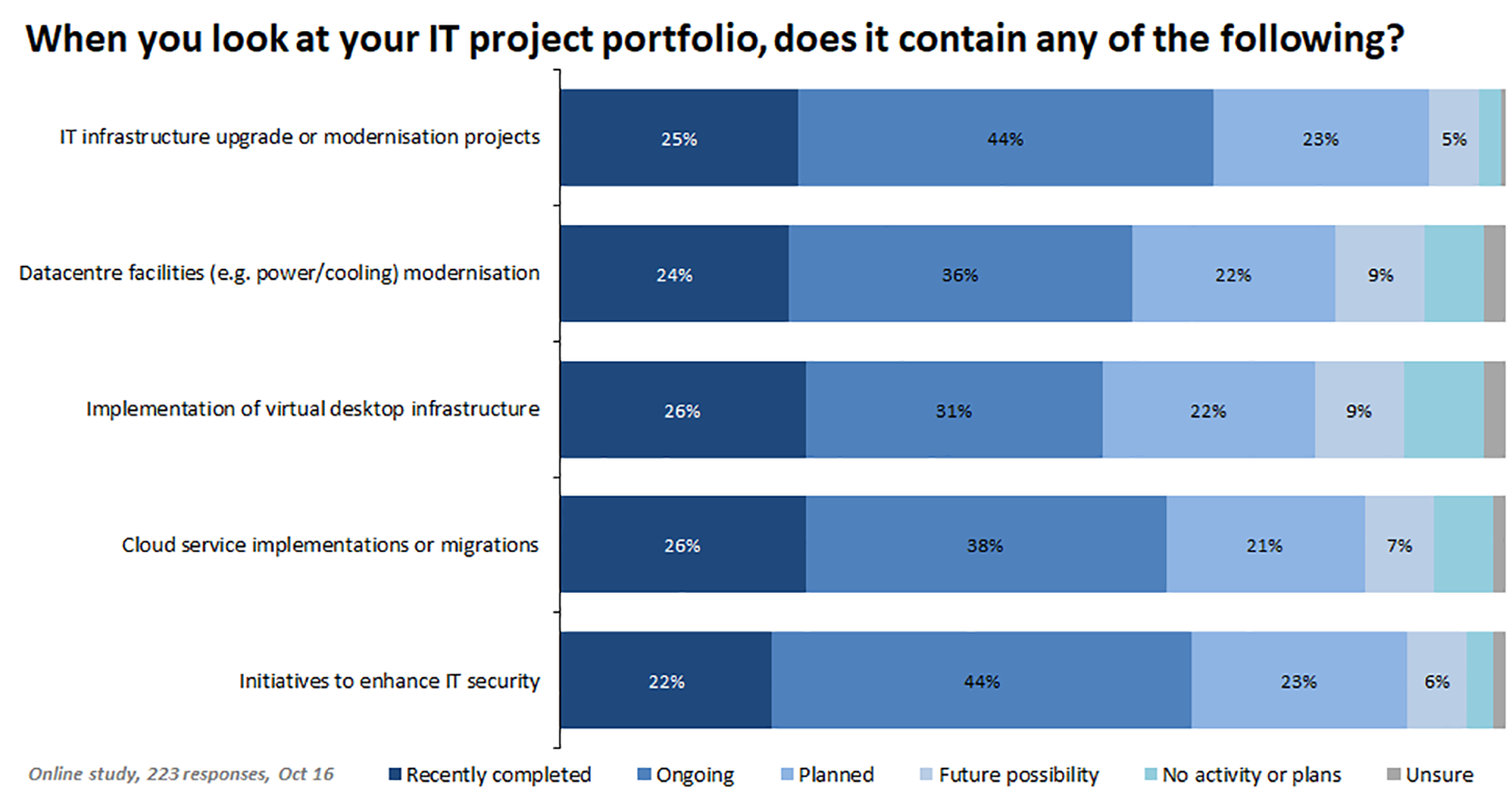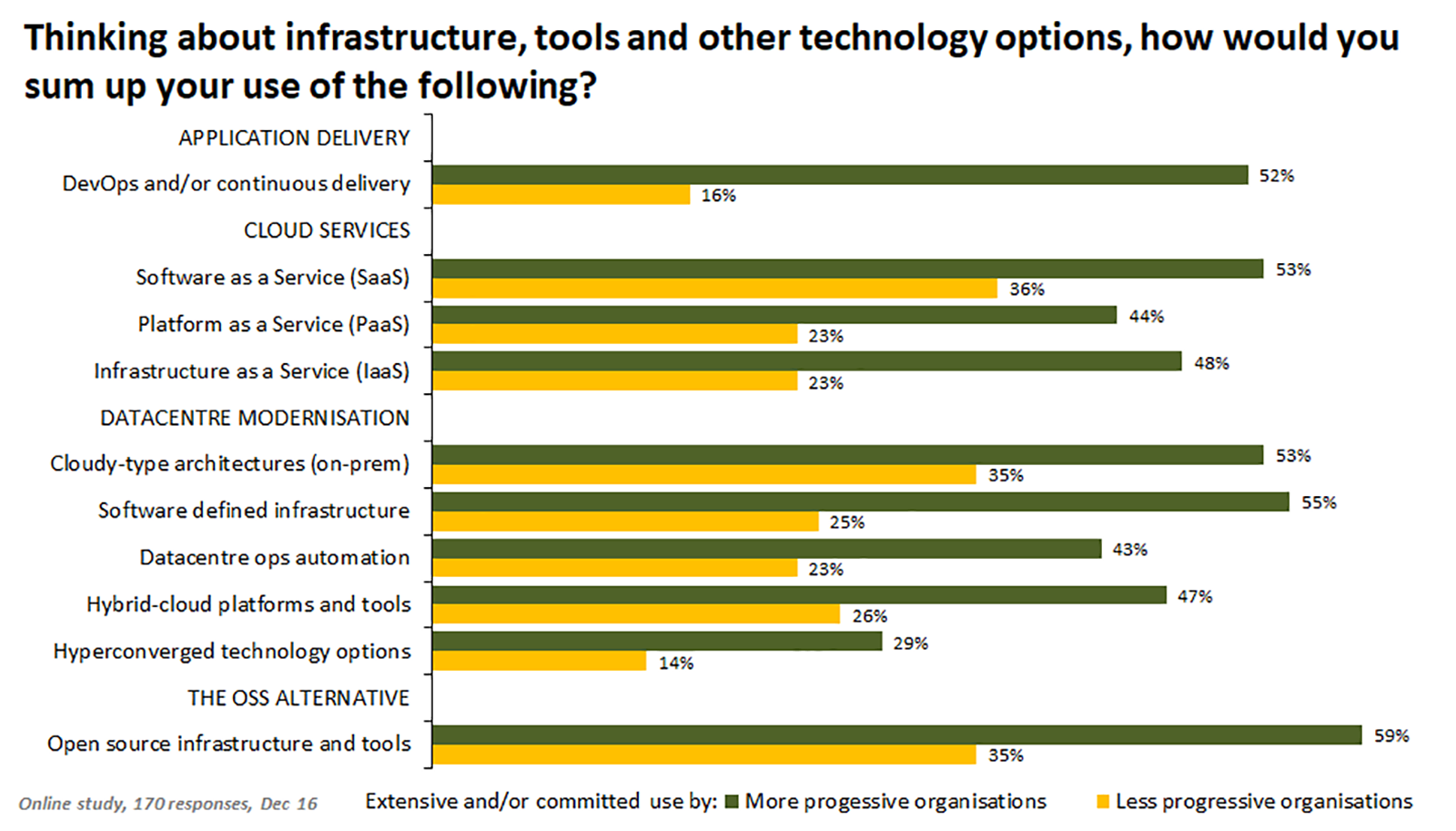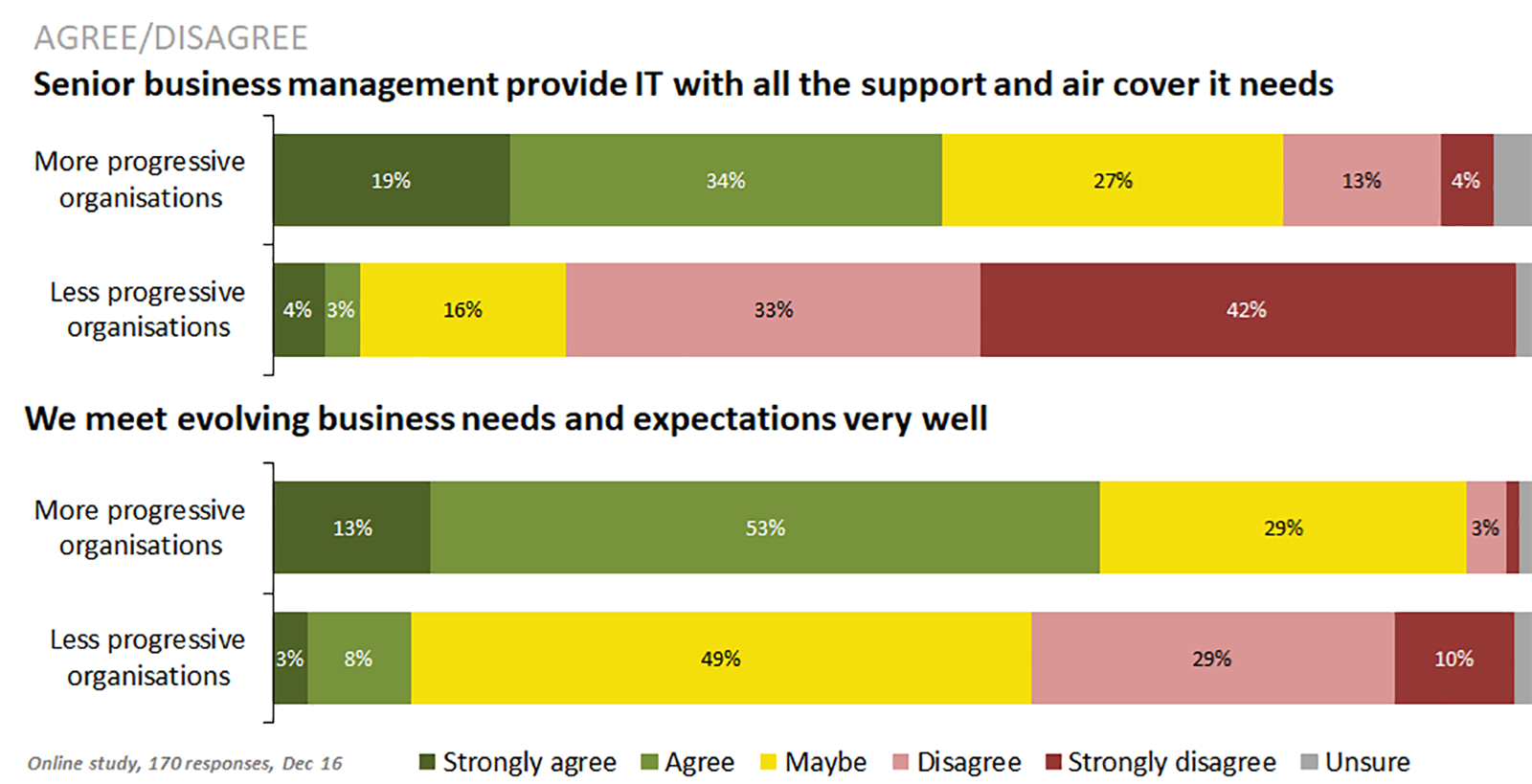A look at recent developments in the delivery of IT Services
For much of the past decade, many vendors and researchers suggested that cloud would become the only sensible model for delivering most IT services. Indeed, in the early days of public cloud marketing they evangelised that it would be the dominant model. Today things have settled down, and the majority now accept that most organisations will consume IT services via a range of models, combining systems running inside their data centres as well as others taken from external clouds. But how are enterprises transforming the way they deliver IT to their users, and what factors are driving that evolution? Recent research carried out by Freeform Dynamics (see here and here) provides a good indication (Figure 1). It is interesting to note that while much is said about the need for IT to become more responsive to rapidly shifting business requirements, a matter of which there is little dispute, a few other factors jump out. It is especially worth considering the “business alignment” results, as these point out some facets with the potential to dramatically impact IT’s responsiveness to business change, or even get ahead of it.
Adopting more collaborative relationships with business stakeholders is essential if IT, and hence the data centre, is to deliver new services rapidly, but it is subtly different from simply reacting to change requests quickly. And if it is combined with IT becoming more proactive, i.e. actually suggesting how IT can help the business move forwards, the potential impacts could be valuable.
One other point from the results also has the potential to modify how many projects will be financed and undertaken going forwards. Over half of the respondents taking part in the survey already see or foresee a shift away from big IT projects towards more continuous improvement models. For many, the days of massive projects taking years to show results are coming to an end. The way forward is to do little and often, always keeping the big picture in mind. This approach is helped by recent advances to make the core IT infrastructure inherently more flexible and rapidly reconfigurable, as ‘software defined’ IT becomes a reality.
While there is plenty of talk about IT and the business working together more effectively, what IT projects are taking place? The answer, perhaps unsurprisingly, is that there are developments across both data centres and public cloud (Figure 2).
It is interesting to note that while much is said about the need for IT to become more responsive to rapidly shifting business requirements, a matter of which there is little dispute, a few other factors jump out. It is especially worth considering the “business alignment” results, as these point out some facets with the potential to dramatically impact IT’s responsiveness to business change, or even get ahead of it.
Adopting more collaborative relationships with business stakeholders is essential if IT, and hence the data centre, is to deliver new services rapidly, but it is subtly different from simply reacting to change requests quickly. And if it is combined with IT becoming more proactive, i.e. actually suggesting how IT can help the business move forwards, the potential impacts could be valuable.
One other point from the results also has the potential to modify how many projects will be financed and undertaken going forwards. Over half of the respondents taking part in the survey already see or foresee a shift away from big IT projects towards more continuous improvement models. For many, the days of massive projects taking years to show results are coming to an end. The way forward is to do little and often, always keeping the big picture in mind. This approach is helped by recent advances to make the core IT infrastructure inherently more flexible and rapidly reconfigurable, as ‘software defined’ IT becomes a reality.
While there is plenty of talk about IT and the business working together more effectively, what IT projects are taking place? The answer, perhaps unsurprisingly, is that there are developments across both data centres and public cloud (Figure 2).
 The results show a wide range of infrastructure project activity, despite the steady increase in expected life of individual items of hardware in data centres. Indeed, the ever-increasing dependence of nearly all business operations on IT requires more IT services to be available without interruption than in the past. This in turn makes itself felt in projects to modernise core data centre facilities such as power systems, power management and cooling.
It is worth noting the slow, but steady, implementation of virtual desktop solutions. In terms of user awareness, desktops, whether physical or virtual, are a focal point for users, who will notice should anything happen to impact service quality or availability. This is therefore yet another critical service that data centre managers must keep an eye on.
Overall, these research results reaffirm a key finding from many other studies executed by Freeform Dynamics in recent years, which is that while public cloud services are growing, the data centre is not heading for extinction. As ever in IT, pragmatism rules. Consequently, the public cloud is simply another delivery option to be considered in the light of all the relevant business, legal and IT requirements, and of how well it fits in with the corporate mind-set (Figure 3).
The results show a wide range of infrastructure project activity, despite the steady increase in expected life of individual items of hardware in data centres. Indeed, the ever-increasing dependence of nearly all business operations on IT requires more IT services to be available without interruption than in the past. This in turn makes itself felt in projects to modernise core data centre facilities such as power systems, power management and cooling.
It is worth noting the slow, but steady, implementation of virtual desktop solutions. In terms of user awareness, desktops, whether physical or virtual, are a focal point for users, who will notice should anything happen to impact service quality or availability. This is therefore yet another critical service that data centre managers must keep an eye on.
Overall, these research results reaffirm a key finding from many other studies executed by Freeform Dynamics in recent years, which is that while public cloud services are growing, the data centre is not heading for extinction. As ever in IT, pragmatism rules. Consequently, the public cloud is simply another delivery option to be considered in the light of all the relevant business, legal and IT requirements, and of how well it fits in with the corporate mind-set (Figure 3).
 This pragmatism is well reflected by deeper analysis of the survey results, where an index of the progressiveness of organisations was built based upon the answers respondents provided to questions around their organisation’s personality/culture (including their attitude to investment, leadership style, and response to external events and developments).
The results revealed some interesting differences, with the more progressive organisations (those with an above average personality/culture score) being more committed in their use of various cloud and data centre solutions compared to the less progressive group. What is an eye-opener is the difference in scale of usage and commitment of more progressive organisations to almost every data centre and cloud solution listed.
Interestingly, the analysis also revealed the importance of executive support in the more progressive organisations to assist in the fast and broad adoption of new IT technologies and ultimately overall performance with respect to meeting evolving business needs and expectations (Figure 4).
This pragmatism is well reflected by deeper analysis of the survey results, where an index of the progressiveness of organisations was built based upon the answers respondents provided to questions around their organisation’s personality/culture (including their attitude to investment, leadership style, and response to external events and developments).
The results revealed some interesting differences, with the more progressive organisations (those with an above average personality/culture score) being more committed in their use of various cloud and data centre solutions compared to the less progressive group. What is an eye-opener is the difference in scale of usage and commitment of more progressive organisations to almost every data centre and cloud solution listed.
Interestingly, the analysis also revealed the importance of executive support in the more progressive organisations to assist in the fast and broad adoption of new IT technologies and ultimately overall performance with respect to meeting evolving business needs and expectations (Figure 4).
 The Bottom Line
The shape of IT infrastructure is changing faster than at any time in history. Data centres are being forced to evolve rapidly to keep up with increasing demands to house expanding numbers of systems and to do so with an expectation that the systems will run 24 by seven, without fail. Getting the technology right is only part of building IT solutions that can drive the enterprise forwards. The need to communicate clearly and effectively with senior business management about why IT investments are valuable to them is just as important as being proactive in IT solution advice to business stakeholders.
Article originally published on DCS UK
The Bottom Line
The shape of IT infrastructure is changing faster than at any time in history. Data centres are being forced to evolve rapidly to keep up with increasing demands to house expanding numbers of systems and to do so with an expectation that the systems will run 24 by seven, without fail. Getting the technology right is only part of building IT solutions that can drive the enterprise forwards. The need to communicate clearly and effectively with senior business management about why IT investments are valuable to them is just as important as being proactive in IT solution advice to business stakeholders.
Article originally published on DCS UK
Tony is an IT operations guru. As an ex-IT manager with an insatiable thirst for knowledge, his extensive vendor briefing agenda makes him one of the most well informed analysts in the industry, particularly on the diversity of solutions and approaches available to tackle key operational requirements. If you are a vendor talking about a new offering, be very careful about describing it to Tony as ‘unique’, because if it isn’t, he’ll probably know.





Have You Read This?
From Barcode Scanning to Smart Data Capture
Beyond the Barcode: Smart Data Capture
The Evolving Role of Converged Infrastructure in Modern IT
Evaluating the Potential of Hyper-Converged Storage
Kubernetes as an enterprise multi-cloud enabler
A CX perspective on the Contact Centre
Automation of SAP Master Data Management
Tackling the software skills crunch